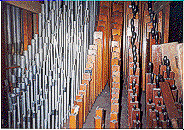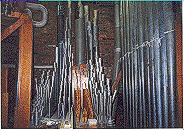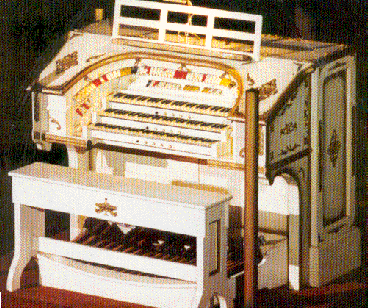Welcome to Universal Restorations | About Us | The Mandeville Organ | The Morey Organ | The Never Ending Project | The Essex Chapel Project | Organ Gallery | Work In Progress | Decorative Facades | Anything Can Be Fixed | Products and Services | Links | Contact Us | Guest Book
 |
 |
 |
|
That's what the locals called it - "The Never Ending Project,” and with good reason. A variety of organ technicians - professional, amateur, and several somewhere in between had all worked on the Wicks Theater Pipe Organ, located in Davenport, IA's Capitol Theater over the last thirty years. It was forever being "restored" or "rebuilt", or otherwise modified.
On behalf of the aforementioned technicians, I will say that each one did his utmost given the almost impossible conditions, the Herculean nature of the task at hand and next to no funding. And I must add that the fact that there finally was funding to work on this instrument at all was due to the more than monumental efforts of the president of the local chapter of the American Theater Organ Society and her husband.
After our initial inspection of the instrument, we were asked, more than once, "Do you really want to do this?"
I suppose the question was not out of line. Much of the plaster and wood lathe ceiling had collapsed onto the portions of the pipe work. The wiring was a profusion of fraying wax-covered cloth and decaying copper. The unification and combination action relays were both of the early electro-pneumatic action - leaked fiercely and were each as large and heavy as a 1958 Buick Roadmaster. (!)
The console had been filled with cotton, mouse traps, and rat poison - a combination we quickly discovered was highly flammable, as on the second day into the project a fraying wire sparked and lit the dry cotton. Fortunately this took place right in front of the eyes of a fast thinking technician - so we still had a console shell to work with and a theater to work in, as opposed to so many - albeit historical - ashes.
The instrument started off its life in the early 1920's as a Moller organ, but fire destroyed everything of the first "incarnation" save the 16'Bourbon, the Kinetic blower, and some cabling. In 1926, Wicks Co. salvaged the few pieces of the Moller organ and constructed a theater organ of 10 "extended" unit ranks that were playable over close to 100 speaking stops, controlled by a three manual and pedal console.
For those uninitiated in the esthetics and logic of theater pipe organs, 10 ranks generating 100 speaking stops is only "moderately unified"! Case in point, a technician who reviewed our work in the early stages suggested that we could have easily doubled the number of speaking stops.
The above comment will serve as a segue into a partial explanation of our philosophy of instrument restoration:
We believe is respecting the past, and where ever possible, preserving it.
As far as theater organs go, The Capitol Theater Wicks is not a "glamorous" instrument. It is of average size and specifications, and contains a modest number of "toys." The chief virtue of this organ is found in the fact that it is the only known Wicks theater pipe organ still in its original location. And it is one of the increasingly few original theater pipe organs that have maintained something close to its original specifications.
Our goal in the Wicks organ restoration was to ultimately allow people to hear the same sounds their grandparents heard when they attended the showing of silent films in a theater that started its life as a Vaudeville palace and on whose stage Jazz legends such as Bix Biederbeck once played, before they had become icons.
To that end we opted not to turn the Wicks into a "hot rod" theater organ - what has become the typical fate of most "restored" theater organs these days
Although it was truly tempting given the cavernous chambers, we opted not to add rank upon rank of additional pipe work, thus turning this little, but mighty sounding ballad organ into something its designers never intended.
Just as tempting were the seemingly endless possibilities engendered by emerging computer technologies. Sequencing, sampling and sound synthesis have all been incorporated into the "modern" theater organ. But here we had the unique opportunity to preserve something of a short-lived but incredibly influential era in American music.
The Wicks Theater Organ at Davenport's Capitol Theater is technically a municipal organ. It is owned by a state run, state funded educational institution. That means it will and must be played by many people, not all of who are prepared to handle a museum piece. And that is where made the following judgment call: Preserve the original tonal esthetics of the instrument, but render the instrument practical enough to withstand the rigors of daily use. To that end, all internal circuitry was replaced with custom built, state of the art solid-state components.
Restoration included not only the organ itself but also the organ chambers - which needed to be shorn up and prevented from further decay. Along the way a water problem needed to be resolved - a storm drain had cracked and was pouring water back into the building. Every pipe on the organ needed to be removed and washed and put back into the chambers. Numerous cracked pipes needed to be repaired or replaced. Most of the fairly well equipped percussion section and "toy counter" needed to be rebuilt. Everything needed to be rewired, and a few items that had vanished over the years needed to be refabricated.
In addition, the chain driven elevator, which allows the console to be raised and lowered during performance, needed extensive repair before it was deemed safe to operate.
One very unique feature of the Wicks organ (admittedly not quite original or authentic) is the inclusion of a "player piano" - an actual upright piano that is controlled from the console and operated pneumatically. This rather ingenious component had been added some decades prior also needed to be completely reconstructed.
Though surely not "glamorous" the Wicks at Davenport's Capitol Theater sounds well in the auditorium owing to uncommonly lush acoustics and excellent placement of the two pipe chambers. Wicks did an excellent job with the design of their Tibia pipes, which are of course the heart (please pardon unintentionally mixed medical metaphors!) of any theater pipe organ.
When played by a fine player, this little ballad organ becomes a thunderous orchestra, rewarding attentive listeners with thrills and chills, and journey to a time that is now barely even a memory.
|